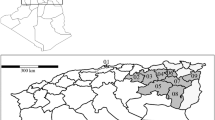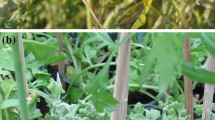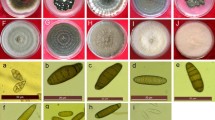Abstract
Pestalotiopsis isolates obtained from the foliage, stem-base and roots of hardy ornamentals grown on commercial nurseries in the UK were identified and characterised according to pathogenicity and colony morphology. All 18 isolates were identified as Pestalotiopsis sydowiana on the basis of conidia morphology, and confirmation of identification was made by experts at CABI Bioscience. Isolates were pathogenic on the host from which originally isolated. Typical symptoms included foliar browning of foliage and stems, and the presence of black or greenish-black acervuli on diseased tissue. Isolates were not host specific and infected other species of hardy ornamentals. Three colony types on potato dextrose agar were distinguished according to colour and production of acervuli by individual isolates.
Three selected isolates of P. sydowiana were characterised by examining the effects of growth media, temperature, pH, and water potential on hyphal extension. Isolates grew well on commonly used growth media, including PDA, Sabouraud dextrose agar (SDA), V8 juice agar (V8), malt extract agar (MEA) and Czapek Dox agar (CDA). The optimum temperature for growth on PDA was in the range 20–25°C, with little or no growth occurring below 5°C or above 30°C. Hyphal extension occurred over a pH range between 2.6–8.6, with optimum values occurring at pH 5.5. In general, decreases in osmotic and matric potential caused a reduction in growth. Hyphal extension on media adjusted osmotically as NaCl ceased between −9.9 and −10.5 MPa. Isolates were more tolerant of osmotic than matric potential, with no growth occurring at −6.5 MPa on media adjusted with polyethylene glycol.
Similar content being viewed by others
References
Adebayo AA and Harris RF (1971) Fungal growth responses to osmotic as compared to matric water potential. Soil Sci Soc America 35: 465–469
Brownell KH and Schneider RW (1985) Roles of matric and osmotic components of water potential and their interactions with temperature in the growth of Fusarium oxysporum in synthetic medium and in soil. Phytopathology 75: 53–57
Cook RJ and Duniway JM (1981) Water relations in the life cycles of soilborne plant pathogens. In: Parr JF, Gardner WR and Elliot LF (eds) Water Potential Relations in Soil Microbiology (pp 119–139) Soil Science Society of America, Madison, Wisconsin, USA
Coyier DL (1987) Leaf spots. In: Coyier AL and Roane MK (eds) Compendium of Rhododendron and Azalea Diseases (pp 25–26) The American Phytopathological Society, St Paul, Minnesota, USA
Coyier DL and Roane MK (1987) Compendium of Rhododendron and Azalea Diseases. The American Phytopathological Society, St Paul, Minnesota, USA
Duniway JM (1979) Water relations of water molds. Ann Rev Phytopathol 17: 431–460
Foster LM, Kozak KR, Loftus MG, Stevens JJ and Ross IK (1993) The polymerase chain reaction and its application to filamentous fungi. Mycol Res 97: 769–781
Gomori G (1955) Preparation of buffers for use in enzyme studies. Meth Enzym 1: 138–146
Hawksworth DL, Kirk PM, Sutton BC and Pegler DN (1995) Ainsworth ; Bisby's Dictionary of the Fungi (Eighth Edition). CAB International, Egham, UK
Handreck KA and Black ND (1994) Growing Media for Ornamental Plants and Turf Culture. University of New South Wales Press, Randwick, Australia
Hopkins KE (1996) Aspects of the biology and control of Pestalotiopsis on hardy ornamental nursery stock. MSc thesis, University of Glasgow, Scotland
Hopkins KE and McQuilken MP (1997) Pestalotiopsis on nursery stock. In: Graham M (ed) HDC Project News No. 39 (p 6) Horticultural Development Council, East Malling
Hyun J-W and Clark CA (1998) Analysis of Fusarium lateritium using RAPD and rDNA RFLP techniques. Mycol Res 102: 1259–1264
Jorge-Silva ML, Rodrigues ML, Ferraz JFP and Ricardo CPP (1989) Effect of water availability on growth of Fusarium oxysporum f. sp. melonis and on host parasite relations. Mycol Res 92: 157–161
Lang ARG (1967) Osmotic coefficients and water potentials of sodium chloride solutions from 0-40 oC. Aust J Chem 20: 2017–2023
LoBuglio KF, Pitt JI and Taylor JW (1994) Independent origins of the synnematous Penicillium species, P. duclauxii, P. clavigerum and P. vulpinum, as assessed by two ribosomal DNA regions. Mycol Res 98: 250–256
Martin MP, Högberg N and Nylund J-E (1998) Molecular analysis confirms morphological reclassification of Rhizopogon. Mycol Res 102: 855–858
Matthew J, Hawke BG and Pankhurst CE (1995) A DNA probe for identification of Pythium irregulare in soil. Mycol Res 99: 579–584
Meng XQ, Shoemaker RC and Yang XB (1999) Analysis of pathogenicity and genetic variation among Phytophthora sojae isolates using RAPD. Mycol Res 103: 173–178
Michel BE and Kaufmann MR (1973) The osmotic potential of polyethylene glycol 6000. Pl Physiol 51: 914–916
Mordue JEM (1971) Pestalotiopsis guepini. CMI Descriptions of Plant Pathogenic Fungi and Bacteria No. 320. Commonwealth Mycological Institute, Kew, UK
Pirone PP (1978) Diseases and Pests of Ornamental Plants. Wiley Interscience, New York
Raynor RW (1970) A Mycological Colour Chart. Commonwealth Mycological Institute, Kew, UK
Slayter RD (1967) Plant Water Relationships. Academic Press, New York, USA
Steuter AA, Mozafar A and Goodin JR (1981) Water potential of aqueous polyethylene glycol. Pl Physiol 67: 64–67
Sutton BC (1961) Coelomycetes I. Mycol Pap 80: 14–15
Sutton BC (1980) The Coelomycetes. Commonwealth Mycological Institute, Kew, UK
Vegh I and LeBerre A (1992) Étude de quelques champignons rencontr´es sur ligneux d'ornement. Phytoma-La defense des végétaux 435: 66–68
White RP (1930) Pathogenicity of Pestalotia spp. on rhododendron. Phytopathology 20: 85–91
Woods DM and Duniway JM (1986) Some effects of water potential on growth, turgor and respiration of Phytophthora cryptogea and Fusarium moniliforme. Phytopathology 76: 1248–1253
Zimand G, Valinsky L, Elad Y, Chet I and Manulis S (1994) Use of the RAPD procedure for the identification of Trichoderma strains. Mycol Res 98: 531–534
Author information
Authors and Affiliations
Rights and permissions
About this article
Cite this article
Hopkins, K., McQuilken, M. Characteristics of Pestalotiopsis Associated with Hardy Ornamental Plants in the UK. European Journal of Plant Pathology 106, 77–85 (2000). https://doi.org/10.1023/A:1008776611306
Issue Date:
DOI: https://doi.org/10.1023/A:1008776611306




